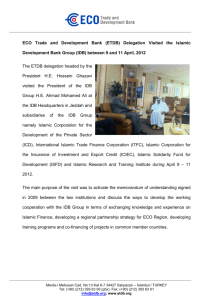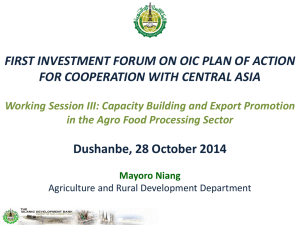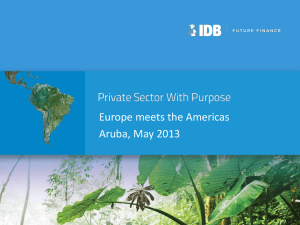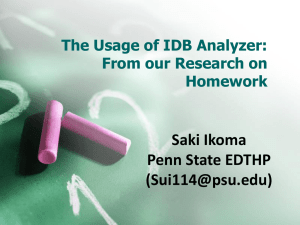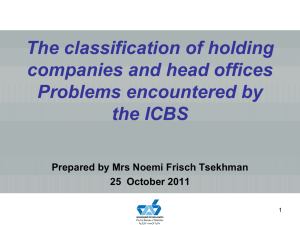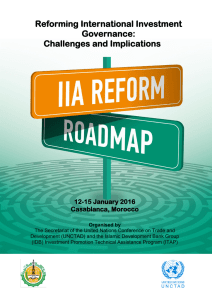center for global
advertisement
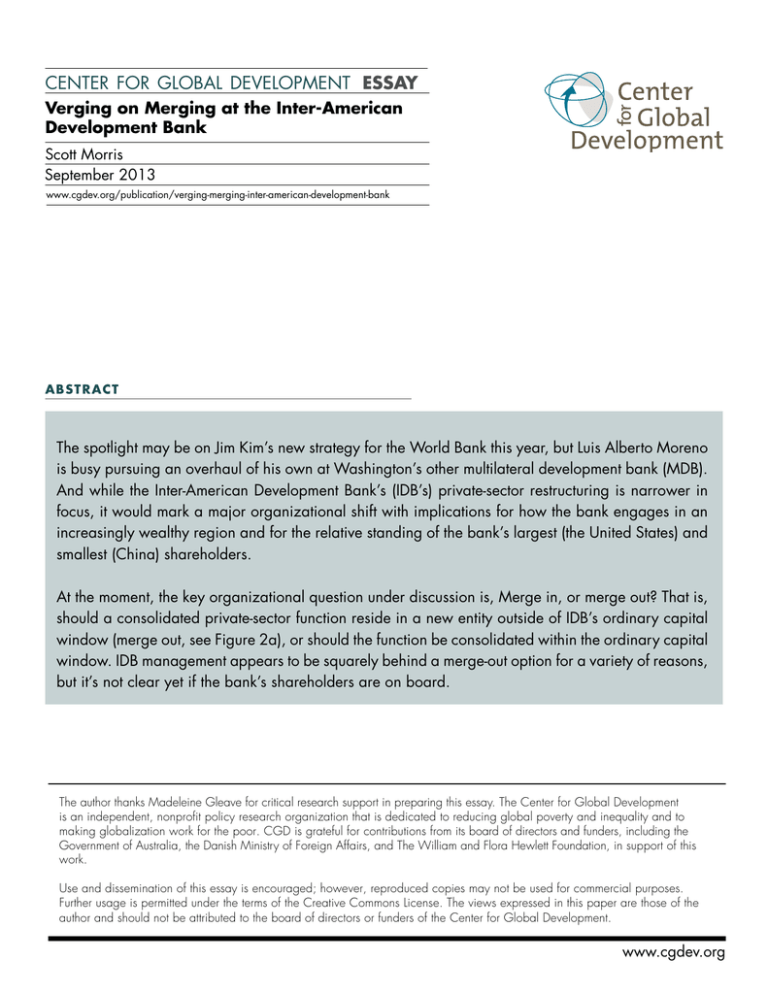
center for global development essay Verging on Merging at the Inter-American Development Bank Scott Morris September 2013 www.cgdev.org/publication/verging-merging-inter-american-development-bank abst r a ct The spotlight may be on Jim Kim’s new strategy for the World Bank this year, but Luis Alberto Moreno is busy pursuing an overhaul of his own at Washington’s other multilateral development bank (MDB). And while the Inter-American Development Bank’s (IDB’s) private-sector restructuring is narrower in focus, it would mark a major organizational shift with implications for how the bank engages in an increasingly wealthy region and for the relative standing of the bank’s largest (the United States) and smallest (China) shareholders. At the moment, the key organizational question under discussion is, Merge in, or merge out? That is, should a consolidated private-sector function reside in a new entity outside of IDB’s ordinary capital window (merge out, see Figure 2a), or should the function be consolidated within the ordinary capital window. IDB management appears to be squarely behind a merge-out option for a variety of reasons, but it’s not clear yet if the bank’s shareholders are on board. The author thanks Madeleine Gleave for critical research support in preparing this essay. The Center for Global Development is an independent, nonprofit policy research organization that is dedicated to reducing global poverty and inequality and to making globalization work for the poor. CGD is grateful for contributions from its board of directors and funders, including the Government of Australia, the Danish Ministry of Foreign Affairs, and The William and Flora Hewlett Foundation, in support of this work. Use and dissemination of this essay is encouraged; however, reproduced copies may not be used for commercial purposes. Further usage is permitted under the terms of the Creative Commons License. The views expressed in this paper are those of the author and should not be attributed to the board of directors or funders of the Center for Global Development. www.cgdev.org Verging on Merging at the Inter-American Development Bank The spotlight may be on Jim Kim’s new strategy for the World Bank this year, but Luis Alberto Moreno is busy pursuing an overhaul of his own at Washington’s other multilateral development bank (MDB). And while the Inter-American Development Bank’s (IDB’s) private-sector restructuring is narrower in focus, it would mark a major organizational shift with implications for how the bank engages in an increasingly wealthy region and for the relative standing of the bank’s largest (the United States) and smallest (China) shareholders. Few seem to disagree about the need for a reorganization of IDB’s private-sector function, which is currently spread across three separate facilities (see Figure 1). Most private investment comes from IDB’s primary lending window, the so-called ordinary capital window. Separately, the bank provides financing for small and medium size enterprises (SMEs) through the Inter-American Investment Corporation (IIC) and grant assistance for private-sector development through the Multilateral Investment Fund (MIF). No fewer than nine independent reports since 2000 have made the case that some sort of consolidation makes sense as a matter of efficiency and policy coherence. Just last year, IDB’s independent Office of Evaluation and Oversight concluded that when it comes to supporting private-sector development, “the current structure and incentives in the IDB Group are inefficient and ineffective in encouraging coordination and synergy.”1 1 Office of Evaluation and Oversight, IDB-9: Assessment of IDB-9’s Private Sector Development Framework (2013), http://www.iadb.org/en/publications/publication-detail,7101.html?id=68344. 1 Despite a long record of such views from the Office of Evaluation and Oversight and other independent experts, various efforts to reform over the years never gained traction. Different this time is that Moreno appears to be highly motivated to get it done as a legacy issue, and he appears to have shareholder support for some sort of reorganization. At the moment, the key organizational question under discussion is, Merge in, or merge out? That is, should a consolidated private-sector function reside in a new entity outside of IDB’s ordinary capital window (merge out, see Figure 2a), or should the function be consolidated within the ordinary capital window (merge in, see Figure 2b)? IDB management appears to be squarely behind a merge-out option for a variety of reasons, but it’s not clear yet if the bank’s shareholders are on board. 2 There are a lot of pieces in play in these discussions, but I see two broad issues at stake. 1. What is an appropriate approach to private-sector development, particularly at a time when Latin America as a whole is not lacking for private capital? 2. What should shareholding and governance look like, and is there an opportunity for the United States to reposition itself to help correct some of the negative governance dynamics that have plagued the bank’s relationship with its largest shareholder for a number of years? Determining the “What” before Deciding on the “How” A rethinking of how IDB organizes itself to do private-sector development also deserves some thinking about what IDB is delivering. It’s fine to want to build a better car, but in the process, you should also think about where you want the car to go. Reportedly, this is exactly where a number of IDB’s shareholders are currently focused. They are open to talking about how IDB could be better organized internally to support private-sector development in the region, but they also want to talk more fundamentally about how IDB engages externally. There’s no shortage of criticism of MDBs’ role as private investors, with the World Bank’s International Finance Corporation (IFC) often the leading target for charges of a lack of “additionality” in its investments. That’s just a jargon-y way of saying that MDBs’ private investments add little or nothing to what the private sector is already doing from a development perspective. Critics argue that IFC and IDB investments simply piggyback on deals that would have happened anyway. This criticism, though overstated, has some merit, whether we’re talking about the World Bank or IDB. As a general matter, the private-sector arms of the banks have a hard time reconciling a deal-driven culture with the broader development policy aims of their institutions. For example, there are no doubt some difficult conversations happening right now within the World Bank about how to bring IFC along in meeting the bank’s goals in fragile states, where financially viable deals are hard to come by.2 But the conversation to be had within IDB looks quite a bit different because the institution serves a region that looks different from other developing regions when it comes to the private sector. Latin America is mostly made up of middle-income countries, where domestic and foreign sources of capital for investment are generally not in short supply. The institutional effect is Center for Global Development colleague Charles Kenny has a thoughtful and innovative approach for IFC that responds directly to the problem of additionality and the challenges of fragile states. 2 3 striking. While the globally oriented IFC works in 59 of the 64 of the world’s countries with per capita incomes below $1,205, IDB’s regional focus means that Haiti and Nicaragua are the only client countries to fall below this threshold. So while IFC might usefully be pushed harder to increase its presence and effectiveness in the poorest countries, IDB can realistically be expected to do so many private deals only in Haiti and Nicaragua (both small economies), along with the handful of other lower-income countries in the region. This raises the more challenging question of what IDB’s private-sector engagement should look like in middle- and higher-income countries. The answer, partly, is that there are broader development policy aims in these countries that could be met by increasing private investment on a targeted basis aimed at key sectors, activities, or excluded populations. For example, IDB has set high-level development objectives around financing infrastructure, micro, small, and medium size enterprises (MSMEs), women-owned businesses, the rural poor, and renewable energy, all of which are as relevant in terms of existing financing constraints in the middle-income countries as they are in the poorest countries. In each of these areas, private financing is constrained. Separate from sectors and populations, IDB could also do more to address macro constraints in its activities and instruments. For example, a reorganized private-sector arm should be positioned to play a more effective countercyclical role to address the procyclical nature of financial access, particularly for MSMEs. More use of local currency finance would also help to address a key constraint to private-sector growth in these economies. What commitments should the shareholders ask of IDB to meet these private-sector-related goals? I think binding private-sector portfolio targets deserve some consideration. Beyond identifying priority sectors, instruments, and activities, the shareholders should make these priorities concrete by setting measurable targets. The virtue of this approach is that it keeps the shareholders out of the day-to-day business of management but creates high-level incentives for the bank’s managers to figure out the details. A consolidated private-sector function could also be an opportunity to be more aggressive on blending financing terms or combining financing tools. The ability to pair a grant with a traditional debt or equity investment without too much bureaucratic hassle could improve the bank’s development impact by unlocking investments that could not be financed on market terms. Such flexibility could also better support a range of activities (traditional investment plus technical assistance) to improve the chances of success in a given investment. Finally, it’s worth noting that if MIF didn’t exist, IDB would probably want to create it as part of this exercise. Its model remains unique among MDBs in its ability to provide a mix of grants, debt, and equity targeted at very-early-stage enterprise development, often in the poorest populations. MIF flexibility extends to its policy approach, which fosters innovation 4 and tolerates the risk associated with such innovation and inherent in the targeted populations. The challenge of the “what” for MIF is more about how to better integrate its functions into a larger private-sector effort. In its ideal form, a reorganized private-sector function would more readily facilitate the graduation of successful MIF investments in microenterprises and start-ups into IIC investments in growing SMEs. This can happen now, but better incentives and coordination are needed to make it commonplace. In general, IDB shareholders are right to prioritize the question, “What?” at this stage. After all, it’s probably better to keep whatever jalopy you have than to build a new car that gets you to the wrong destination faster. Shareholding and Governance Matters IDB’s private-sector reorganization also provides an important, though not obvious, opportunity to consider the bank’s shareholding and governance structure. One likely motivation for IDB management’s support for merge-out is the additional flexibility it provides in attracting new funding outside of the constraints of the bank’s governance rules. Like all MDBs, IDB is governed by a shareholding formula for its country members under which relative shareholding is essentially fixed. Most important, according to the rules, the United States must account for no less than 30 percent of IDB’s shareholding. From a financing perspective, this means that any effort to raise additional capital for the bank, whether to support more lending to governments or more private-sector investments, must include a 30 percent share from the United States. The experience of IDB’s 2010 capital increase demonstrates just how binding this constraint can be. At the time, Latin American countries and IDB’s president were calling for a $200 billion increase in the bank’s capital base. Yet the actual increase was $70 billion, determined solely by the United States’ willingness to pay3 and a US view that demand for IDB lending would not be high enough to support the proposed level of capitalization.4 The ability of the United States to exercise control unilaterally over the size of the capital increase proved to be profoundly irritating within the bank and among many of its shareholders, engendering a great deal of political backlash from the region. In the midst of the negotiations, Brazilian Planning Minister Paulo Bernardo told the press that the United 3 Of the $70 billion commitment, just $1.7 billion (2.4 percent of the total) was “paid-in” capital, or funds actually contributed directly to the institution. The balance entailed a contingent commitment of “callable” capital. As a result, the 30 percent US share of the paid-in contribution was just over $500 million. Under the $200 billion scenario, which also could have entailed a higher percentage share of paid-in capital, the US contribution would have skyrocketed to $3.5 billion (assuming a paid-in share of 6 percent). 4 In the face of this skepticism and US resistance, regional advocates shifted to calls for a $100 billion capital increase before settling for the $70 billion increase that the United States was willing to endorse. 5 States was on a “crusade” and was taking a position that would be “very grave” for IDB and the region.5 The US delegation heard this viewpoint expressed in even stronger terms by many of the region’s representatives during closed-door sessions. In contrast, very little of this political conflict was evident (and none aimed directly at the United States) in the negotiations and discussions around capital increases at the other MDBs, which were occurring at the same time. Important to note, while the United States is the largest shareholder in most MDBs, it is disproportionately large at IDB.6 For example, although many view the World Bank as a U.S.-dominated institution (an attitude most likely driven by the unbroken run of American presidents of the bank), US shareholding in that institution is just under 16 percent. So what does the United States get for its whopping 30 percent at IDB? Well, a lot of headaches mostly. Not because leadership in the institution isn’t worth the effort. IDB does good and important work in the region and plays a useful (often foundational) role in supporting US economic priorities in Latin American and Caribbean countries. Rather, it is the size of the shareholding that is a headache. Thirty percent shareholding is too much for one country to have in a multilateral institution and, by definition, far too little for a bilateral tool. Why too much? I see three reasons: 1. Shareholding at this level sets expectations within the United States (particularly in the US Congress) that the US government can and will call the shots within the institution. Yet the 30 percent shareholding provides only veto authority over a narrow, albeit important, set of decisions such as capital increases. In terms of the day-to-day decisions taken in the bank’s board of directors, the far more powerful number is 50.01 percent—the amount of shareholding held by the bank’s regional members (minus the United States and Canada) since most board decisions need only a simple majority. The United States has no ability to unilaterally block (or push forward) individual loans and projects, bank policies and strategies, or any other decision brought to the board. In this way, shareholding of 30 percent doesn’t look much different from shareholding of 16 percent. 2. One way that 16 percent does look different from 30 percent is as a share of shareholders’ financial contributions. It doesn’t take much math to realize that it costs a lot more to be a 30 percent shareholder than a 16 percent shareholder. That’s bad for the United States as a matter of fiscal burden and bad for the bank in limiting the size of the institution solely to meet the fiscal requirements of one shareholder. See http://www.bloomberg.com/apps/news?pid=newsarchive&sid=aHwQS5Z5RQdk. The United States is the largest shareholder in the World Bank, IDB, and the European Bank for Reconstruction and Development; the coequal largest shareholder (with Japan) in the Asian Development Bank; and the largest nonregional shareholder in the African Development Bank. 5 6 6 3. On the issues wherein the United States can exercise a veto, discussions become polarized too readily, with the other shareholders quick to portray the United States as an obstacle and the United States perhaps too quick to play that role unilaterally. The 2010 capital increase included an ambitious set of policy commitments, virtually all of which were spearheaded by the United States. While a number of these commitments had wider support, the agenda as a whole became associated with the United States alone. Subsequently, implementation has proved challenging, particularly in areas where the United States did not have broader support at the time of the commitment.7 IDB’s private-sector reorganization will not fix the problems associated with outsized US shareholding, but it does present an opportunity to alleviate them. Under a merge-in scenario, the United States could allow its shareholding to be diluted by permitting other countries to provide additional capital to support a more robust private-sector function. Depending on the size of dilution, this move could require a number of changes to the bank’s articles of agreement, normally a cumbersome process.8 However, were the United States to signal a willingness to pursue it, I suspect that the other shareholders would rally quickly. Directly affecting shareholding at the bank under merge-out is less straightforward. A new entity, presumably with its own shareholding structure, would be created, leaving the shareholding of the ordinary capital window unchanged. The United States could choose to take a much smaller position in the new private window. However, a large misalignment in shareholding between the bank’s private-sector and nonprivate-sector (“sovereign”) arms could introduce a new set of problems. It would be a challenge for overall governance in IDB, for example, for the United States to take a 1 percent position in the new private-sector window and retain 30 percent in the ordinary capital window. Policy coherence would likely suffer under this arrangement given the different character of the two executive boards. Instead, the United States could consider a package that revisited the 30 percent shareholding in the ordinary capital window while staking out a leadership position on a smaller scale in the private-sector arm. For example, a creative solution would allow some of the United States’ existing ordinary capital shareholding to migrate over to the new private- 7 One of the most controversial commitments leveraged by the United States was to provide Haiti with $200 million in grants each year, funded entirely by IDB income. This commitment, $2 billion over ten years, meant that more money would be paid out by the institution than was paid in by shareholders under the capital increase ($1.7 billion). In effect, the 2010 capital increase was actually a $300 million capital decrease. Not surprisingly, the Haiti support remains controversial among IDB’s regional shareholders, and IDB’s ability to maintain support for it each year is unclear. 8 Although I don’t take a view here on the right amount of dilution, it is worth noting that the limited veto power of the United States is preserved above the 25 percent shareholding level. As a result, dilution from 30 to 25 percent would allow the United States to retain its veto without any changes to IDB rules. 7 sector window, paired with a selective capital increase for the ordinary capital window to replace some or all of the migrated capital. Whatever the arrangement, it’s worth considering which countries the United States would be making space for by agreeing to take up fewer shares in the institution. It would be important to pursue a balanced approach in any shareholding realignment within the bank. Although the Chinese government has been particularly aggressive in seeking to boost its shareholding from its current level of 0.004 percent, it would similarly affect policy coherence to have a Chinese-dominated private-sector window and a US-dominated ordinary capital window. One model for shareholding realignment is provided by the way in which IIC itself managed the reallocation of a small number of shares that the United States made available two years ago. At the outset, IIC set limitations on the ability of any one country or grouping (regional versus nonregional) to purchase all of the shares. So far, the result has been a relatively balanced purchase of shares, with Canada taking up 150 shares and China and Korea each taking 40.9 The IIC experience represents on a more modest scale the benefits of some realignment in IDB. The United States was able to alleviate some of the fiscal burden associated with its large IIC shareholding. In the process, the United States also earned some goodwill among the other shareholders by making more shares available to those who wanted them. As a result, IIC ended up with a shareholding structure in which the United States is still largest but with greater balance overall. A Grand Bargain So what might a grand bargain look like when it comes to a private-sector reorganization at IDB? Given IDB management’s expressed preference for a merge-out option, let’s consider the deal that could make it a reality. The United States ought to be willing to accept dilution in two ways. First, the United States should not seek 30 percent shareholding in the private-sector entity. By accepting a smaller share of the new entity, the United States would open the door to new contributions, allowing for a larger entity than what would be possible with a “no dilution” stance. The United States should also accept some dilution in the ordinary capital window so that any transfer of capital from ordinary capital to the new entity could be replaced with a selective capital increase. Fredel, Theresa Paiz, and Diego Alcazar, Inter-American Investment Corporation (IIC): Full Rating Report (2013), http://www.iic.org/sites/default/files/pdf/iicdocs-352941-v1-iic-full_rating_report_by_fitch-2apr13.pdf. 9 8 What does the United States get in return? Certainly, better relations with the region and as a result a better-governed IDB with a broader base of support for the bank’s policy agenda, in which the United States can continue to play a leadership role. But there could be more to the bargain, which brings us back to MIF. The United States is the largest financial supporter of MIF and one of its strongest advocates. Yet as MIF faces the need for another replenishment of its resources, its largest donor is not well positioned in an era of sequestration to be ambitious in a new funding round. So in exchange for standing out of the way (dilution) while other shareholders provide additional capital to IDB, the United States could reasonably ask that the bank itself ensure adequate funding for MIF, whether through the earnings of the new private entity or through the earnings of the ordinary capital window, as in the case of the grant facility for Haiti.10 But Do We Need a Bigger IDB? The various dilution options raised here imply more capital flowing into IDB to support higher levels of private-sector and/or sovereign lending. But does IDB need more money from a development perspective? Put differently, is there demand in the region to support higher levels of activity from IDB? Unfortunately, the experience with so-called demand analyses at the time of the 2010 MDB capital increases demonstrates that attempts to answer these questions analytically allow for a wide range of possible outcomes and, as a result, are highly susceptible to political bias. Short of extreme options (a $500 billion capital increase anyone?), the more practical test of an IDB capital increase may be the willingness of the shareholders as a group to pay. So while the willingness of the United States alone to pay may have a distortive effect on the institution, the collective view of the shareholders (borrowers and nonborrowers together) may very well provide the best shot at legitimacy as a measure of what the institution can seek to accomplish in the region and the money it needs to do so. Conclusion It should not be controversial for IDB and its shareholders to use the opportunity of an internal reorganization to consider the fundamentals of what the bank is doing externally on private-sector development. Given the nature of the region and its economies, the challenge is to ensure the bank is appropriately focused in its efforts so that IDB investments are truly additional from a development perspective. 10 As a first step, shareholders could agree to channel some of the $200 million annual grant money dedicated to Haiti into MIF to support MIF work in Haiti and possibly other lower income IDB borrowing countries. 9 Using the opportunity of a reorganization to revisit shareholding and governance certainly enters the realm of the controversial. That said, the United States would do well to consider the counterintuitive proposition that some ceding of shares could strengthen rather than diminish its standing in the institution and in the region. And in the process, a deal that puts MIF on a sustainable path would be a win for everyone. 10

